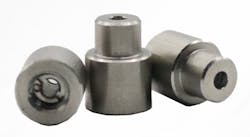Fiber Collimator made of stainless steel; size: ∅6.81mm x 9.27mm
A fiber collimator is an optical component designed to transform the light emitted by an optical fiber into a collimated beam of light with a specified diameter, or to a designated spot size. Used in reverse, they can also be used to focus light into a fiber. At Shanghai Optics we produce a wide range of custom high quality fiber optic collimators with various focal lengths and aperture sizes. Our fiber collimators can be used for funneling light in and out of SMA, FC/APC, or FC/PC terminated fibers. They are compatible with single mode, multi-mode and polarization maintaining fiber, and can be used for applications in communications and data transfer, with pigtailed receptacles or with fiber coupled lasers.
Our fiber collimators are diffraction limited, enabling very small spot sizes and beam diameters. Antireflection coatings on the component lenses minimize back reflection. Our collimators feature extensive operating distance and have low insertion loss, and are very easy to integrate into existing systems. State of the art metrology allows us to ensure that each fiber collimator will perform stably and optimally in the application it was designed for.
Understanding Fiber Optic Collimators
Light emitted directly from an optical fiber will be a cone of illumination, with a divergence angle approximately equal to the input angle. In order to produce beam-like outputs, a fiber optic collimator can be used to collimate the light, creating a beam with parallel rays and minimal spread.
At its most basic, a fiber collimator consists of a lens and an optical fiber, housed in a stainless steel housing with appropriate connectors. The mechanical connectors enable the collimator to be easily attached to or removed from a connectorized fiber.
The type of lens and the exact configuration of the collimator depends on the application in which it will be used. Most fiber collimators produced today utilize Graded Index (GRIN) lenses, which are small optics with plane surfaces that focus light through the continuous change of refractive index within the lens material itself. For larger beam sizes (1 mm to 5 mm), aspherical lenses may be used to focus the light. Spherical singlet or doublet lenses are often selected when a beam size of greater than 4 or 5 mm is needed. These fiber collimators are larger in size than those for smaller beam sizes. Note that the relative mode size of the fiber and beam size is not the same; in fact, a smaller fiber mode size will result in greater divergence and larger collimated beams.
Two fiber collimators can be used as a pair to couple light from one fiber to another through a free-space beam. The first collimator would be set up to transform the diverging light output of the first fiber into a collimated free space beam with a nearly constant diameter. The second collimator would receive this beam and couple the light into the second fiber. As in any coupling, careful alignment and stabilization is the key to minimal power loss.
Fiber Optic Collimators at Shanghai Optics
We’re able to work with you to customize the perfect solution for your application. Contact us if you’d like more information or a free consult.
